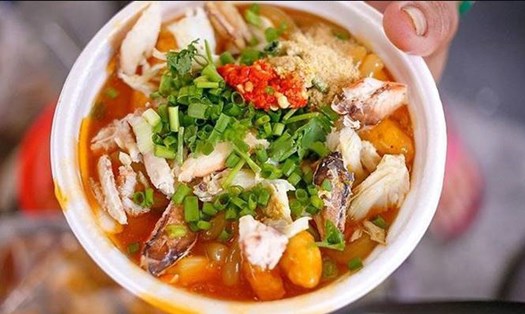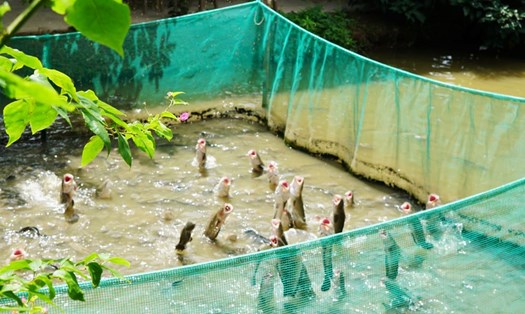I thought it was a Quang Tri-style snakehead fish porridge made from flour, but when I stirred it with a spoon, I realized it wasn't. There was no porridge in this bowl of flour porridge.
PORRIDGE THAT IS NOT PORRIDGE
Actually, this is just a bowl of snakehead fish noodle soup, but if you want to call it noodle soup, please come to Hue and order it, but in this country, this is rice porridge, or bed flap porridge. Bed flap is also called bed slat, which also contributes to the excitement of this dish, but simply put, the dough is rolled and cut into flat square strands, looking very similar to bed slats.
The ingredients of this porridge bowl include only 2 main ingredients: Kneaded dough rolled into strands and braised snakehead fish. The broth is fish stock, simmered with the backbone, head and tail of the fish. The indispensable spices of this snakehead fish porridge dish are Chinese scallion (scallions), Chinese scallion leaves, chili and Vinh Linh pepper.
Like pho in Hanoi, hu tieu in Sa Dec, and hen rice in Hue, snakehead fish porridge is the most popular dish in Quang Tri, attached to everyone's memories. It is difficult to find a Quang Tri person who has never eaten snakehead fish porridge or whose eyes do not light up when mentioning this "spirit, quintessence" dish.
Because, like the delicious Quang Tri dishes that Lao Dong Cuoi Tuan introduced in previous issues such as bun chat chat, bun nghe, snakehead fish porridge is also a dish for poor children and workers. Snakehead fish are raised in the fields, the flour is made from home-grown rice, and the taro grows everywhere, there is nothing difficult to find.
Therefore, snakehead fish porridge has become the value and pride of Quang Tri people. The local ingredients have also made the bowl of snakehead fish porridge here have a different flavor from the bowl of snakehead fish noodle soup in other regions, especially the spicy and aromatic flavor of the nuong root has created a unique flavor, without the nuong root, it would not be porridge.
When I tried to ask why it was necessary to call this “porridge” and not noodles or rice noodles because the way to make the dough is very similar to these two things, I finally found the answer that, although the dough is rolled into strands, it must be cooked to a consistency like porridge, so thick that it can be eaten with a spoon like porridge.
So when should you eat porridge? The answer is simple: you can eat porridge at any time because it is sold from early morning to late at night. Porridge eaten early in the morning, especially after a night of drinking, is really wonderful.
The viscous but not thick liquid, made from the powder, will coat the stomach and intestines, helping to soothe the stomach. The rich flavor of the braised snakehead fish will awaken the taste buds, while the spicy, hot, aromatic flavor of the tubers and leaves also helps to dispel wind and cold, increasing comfort.
A bowl or two of porridge in the morning is enough energy to start a new day. Don’t worry about people judging you for eating too much, because these dishes in Quang Tri are all served in small bowls, and a big eater can easily “destroy” a few bowls.
Eating rice porridge at noon also has its own interesting features. As you eat, you sweat, and when you encounter a cool breeze, your pores will feel as good as death, because "a hundred soldiers fanning you are not worth a single breeze". Thinking back to the noon in Khe Sanh, in the middle of a summer afternoon but the weather was freezing cold because of the jungle rain, I stopped by a rice porridge shop to sip a bowl, and immediately felt my body warm up.
Eating porridge late at night is also an interesting experience in the journey of experiencing porridge in this land. Cua Viet port was immersed in darkness, only the lights of porridge stalls along the coastal road remained. The wind blew through the rustling poplar trees, the waves lapped the sand, and mixed in with that sound were the sounds of slurping porridge and the sounds of exclaiming over the spicy and hot taste, so enchanting.
Just eat once but remember forever
How is porridge cooked that it can be so attractive, creating a spiritual value in the soul of Quang Tri people that is different from the snakehead fish porridge of the West, the fish noodle soup along the South Central coastal provinces or the snakehead fish porridge in Hanoi?
Although this dish looks simple in structure, it also requires elaborateness in processing. That is a rule in cooking, the simpler the dish in terms of ingredients, the more meticulous it needs to be in the cooking process. The flour to make porridge includes 2 types: rice and wheat.
With regular rice, choose good quality rice, when cooked it will produce flour that is neither dry nor wet. The rice is washed, soaked in water for about 2 hours, then ground. Put the ground rice in a clean cloth, tie it tightly, then use a heavy object to press down on top to drain all the water from the rice, wait until you get dry flour, then knead it.
The dough must be kneaded evenly until it is soft, smooth and has a certain elasticity. The dough must not be too wet or too dry so that when cooked, the dough strands do not break or become hard. This is also considered an important step that determines the quality of the porridge. The dough is then rolled out with a bamboo tube and cut into bite-sized strands.
Porridge is also made with wheat flour, originating from the period when Vietnam received wheat flour as food aid in the 1980s. Wheat flour is kneaded, kneaded, rolled and cut into strands more easily than rice flour, and it is this strand that gives rise to the name bed flap porridge.
Going back about 300km to Nghe An, we will encounter a similarly prepared dish called porridge soup, however, the broth is simmered from pork bones, and the fillings are also more diverse, not purely snakehead fish. Therefore, when entering any porridge shop in Quang Tri, customers will be asked if they want to eat rice flour porridge, wheat flour porridge or tapioca porridge.
Snakehead fish is also an important ingredient. It must be wild snakehead fish because the meat is firmer and more fragrant than farmed snakehead fish. In addition, the fish must be large enough so that the head, tail, and bones can be stewed into a sweet broth, without the need for MSG or seasoning powder.
Fresh snakehead fish is scaled and cleaned. The fish intestines are cleaned, marinated with spices and stir-fried to reduce the fishy smell because this is the soul of this dish. The fish intestines add richness to the porridge, especially porridge from Hai Lang. Therefore, when eating, remember to ask for a whole set of intestines to enjoy it.
The fish is boiled and then carefully filtered to get boneless fish pieces. The backbone, head and tail of the fish are put back into the pot to simmer to get the broth to season the porridge to make it more flavorful. The fish is marinated with fish sauce, salt, pepper, crushed taro, chili, then braised with shallots to create a fragrant aroma, then set aside.
When the pot of broth boils, add the thinly sliced noodles and cook until the noodles are soft. When eating, drop a handful of green chopped perilla leaves into the bowl, then scoop the porridge into it, then pick up the braised snakehead fish and fish intestines and place on top. Sprinkle with ground pepper, a few slices of fresh chili, and a few pickled perilla leaves and you're done.
A bowl of snakehead fish porridge looks ivory white in color, with a layer of fragrant fried snakehead fish on top, along with flat white flour noodles, with added onions, cilantro, and spicy chili peppers. The highlight is the cooked snakehead fish intestines, then the broth is poured over the surface.
When eating, you will feel the soft, slightly chewy noodles mixed with the sweet and fragrant broth, the sweet and rich fish pieces, chewy but not mushy, imbued with the spicy taste of pepper, chili, and shallots, making you sweat while eating, unable to hold back the exclamation because of the spicy numbness clinging to the tip of your tongue. Guaranteed, eating once will be unforgettable.




